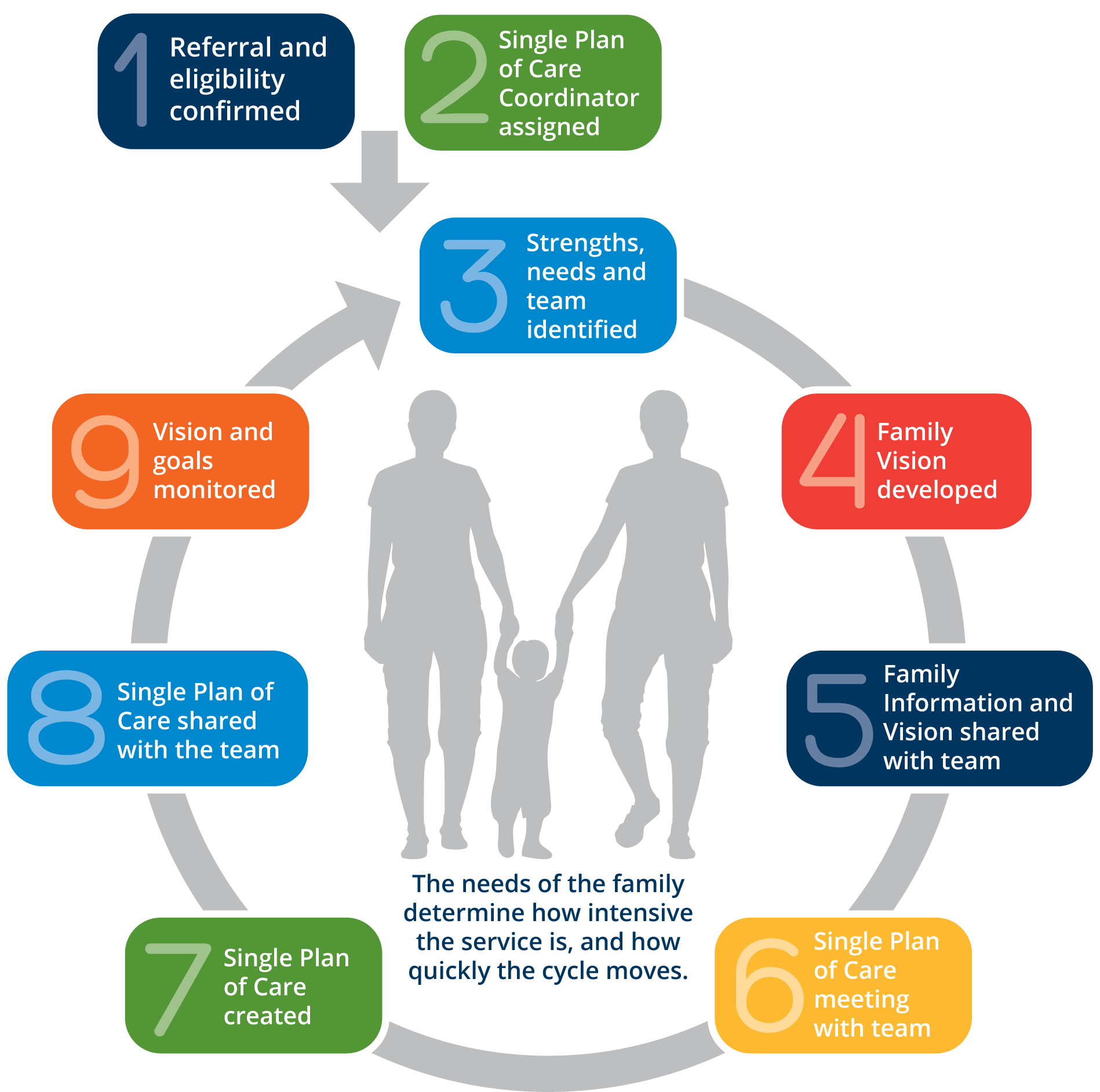CSP Process
Coordinated Service Planning Cycle
1. Referral
Referrals to Coordinated Service Planning can be made at any point a child/youth’s needs are recognized to be multiple and/or complex. Being referred to Coordinated Service Planning should not prevent a family from accessing other appropriate services.
2. Intake and Assessment
When a family is referred to Coordinated Service Planning, they will be assessed to determine whether they should receive Coordinated Service Planning and at what intensity.
9. Services and Goals are Monitored
Coordinated Service Planners will make referrals/connections as new needs and potential supports are identified and/or call meetings with service providers when the family indicates that their goals have changed or that the plan needs to be adjusted.
8. Plan is Documented and Shared with Providers
With the consent of the family, it is the responsibility of the Coordinated Service Planner to make sure that the Coordinated Service Plan is shared with the relevant service providers. Coordinated Service Planners are responsible for communicating, with consent, about the child/youth’s needs, strengths, family/youth’s goals and priorities to service providers and educators.

3. Service Planning Coordinator Assigned
A relationship with a Service Planning Coordinator may be developed as part of the process of identifying and assessing needs and strengths. By the time a family is ready to set goals, a Service Planning Coordinator must be formally assigned/identified.
4. Strengths and Needs Identified
A strengths-based approach will be used to inform the development of the Coordinated Service Plan, including areas where children/youth and their families have strengths and areas where they could be supported.
5. Goals Set and Prioritized
Goal setting will be based on what the family and/or child/youth sees as the most important. Goals can be related to specific activities, therapies, or other domains of development. Goals can also be prioritized based on what is most urgent for the family.
7. Coordinated Service Plan Developed/Updated
The Coordinated Service Plan should aim to encompass every type of service that will be required by, or would be beneficial for the child/youth. Families can expect their Coordinated Service Plan to be a living document that grows and develops with their child/youth. The needs and goals of children/youth and families will change over time, and so will their Coordinated Service Plan.
6. Provider Team Identified
A team meeting may be needed to develop the plan. Family members (parents/guardians), and child/youth as appropriate, are critical partners in Coordinated Service Planning and should be identified as equal members of the team. With family and/or child/youth consent, the team may include providers from outside the children’s services sectors, e.g. from school, healthcare, child welfare.
1. Referral
Referrals to Coordinated Service Planning can be made at any point a child/youth’s needs are recognized to be multiple and/or complex. Being referred to Coordinated Service Planning should not prevent a family from accessing other appropriate services.
2. Intake and Assessment
When a family is referred to Coordinated Service Planning, they will be assessed to determine whether they should receive Coordinated Service Planning and at what intensity.
3. Service Planning Coordinator Assigned
A relationship with a Service Planning Coordinator may be developed as part of the process of identifying and assessing needs and strengths. By the time a family is ready to set goals, a Service Planning Coordinator must be formally assigned/identified.
4. Strengths and Needs Identified
A strengths-based approach will be used to inform the development of the Coordinated Service Plan, including areas where children/youth and their families have strengths and areas where they could be supported.
5. Goals Set and Prioritized
Goal setting will be based on what the family and/or child/youth sees as the most important. Goals can be related to specific activities, therapies, or other domains of development. Goals can also be prioritized based on what is most urgent for the family.
6. Provider Team Identified
A team meeting may be needed to develop the plan. Family members (parents/guardians), and child/youth as appropriate, are critical partners in Coordinated Service Planning and should be identified as equal members of the team. With family and/or child/youth consent, the team may include providers from outside the children’s services sectors, e.g. from school, healthcare, child welfare.
7. Coordinated Service Plan Developed/Updated
The Coordinated Service Plan should aim to encompass every type of service that will be required by, or would be beneficial for the child/youth. Families can expect their Coordinated Service Plan to be a living document that grows and develops with their child/youth. The needs and goals of children/youth and families will change over time, and so will their Coordinated Service Plan.
8. Plan is Documented and Shared with Providers
With the consent of the family, it is the responsibility of the Coordinated Service Planner to make sure that the Coordinated Service Plan is shared with the relevant service providers. Coordinated Service Planners are responsible for communicating, with consent, about the child/youth’s needs, strengths, family/youth’s goals and priorities to service providers and educators.
9. Services and Goals are Monitored
Coordinated Service Planners will make referrals/connections as new needs and potential supports are identified and/or call meetings with service providers when the family indicates that their goals have changed or that the plan needs to be adjusted.
